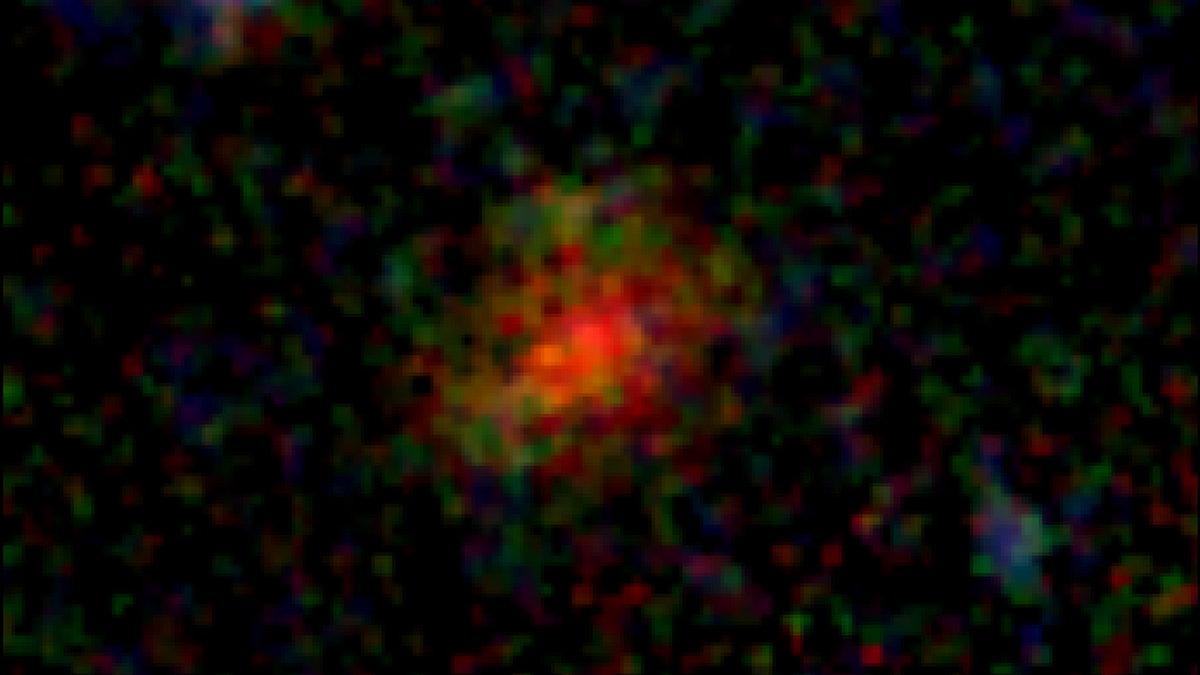James Webb Space Telescope pierces through dust to find an ancient ghostly galaxy
"It's potentially telling us there's a whole population of galaxies that have been hiding from us."

This image of a galaxy from the early universe is hardly what you'd call dazzling.
You are looking at a very blurry, highly dust-obscured resident of the cosmos whose name is only a string of numbers and letters. It even sits at a distance so far from Earth that it slips in and out of the watchful eyes of various telescopes. The image, captured by the powerful James Webb Space Telescope, spotlights galaxy AzTECC71 — but what's striking here is that we're seeing AzTECC71the way it was just 900 million years after the Big Bang. That's when the universe was turning on its very first stars, absolute eons before our solar system was born.
The James Webb Space Telescope's view of this galaxy as a hazy speck of light is a far cry from many other glorious images of galaxies and galaxy clusters in its repertoire. However, even this smudge holds important lessons for our understanding of the early universe.
"The fact that even something that extreme is barely visible in the most sensitive imaging from our newest telescope is so exciting to me," study author Jed McKinney of the University of Texas at Austin said in a statement. "It's potentially telling us there's a whole population of galaxies that have been hiding from us."
Related: James Webb Space Telescope finds 2 of the most distant galaxies ever seen
This could mean the early universe was much dustier than previously thought, scientists say, shedding a little more light on how it evolved since the Big Bang occurred roughly 13.8 billion years ago.
AzTECC71 was first spotted as an incomprehensible blob of light by the James Clerk Maxwell Telescope in Hawaii. Later, it was also seen by the ALMA radio telescope in Chile. Then, however, it seemed to vanish in images taken by the Hubble Space Telescope.
Breaking space news, the latest updates on rocket launches, skywatching events and more!
"This thing is a real monster," said McKinney. "Even though it looks like a little blob, it's actually forming hundreds of new stars every year."
As part of an international effort to map the earliest structures of the universe (in a chunk of the sky the size of three full moons as seen from Earth), McKinney and his colleagues looked for the galaxy in data collected by the JWST. This observatory's powerful, unprecedented infrared eye is capable of peering into dust-thick clouds prevalent in the early universe.
Before the JWST, these galaxies were close to impossible to seek out. The light from birthing stars, sitting deep within dust-shrouded galaxies, was absorbed in optical wavelengths by the dust itself and re-emitted at faint, longer wavelengths that the JWST can pick up. One in five such galaxies had remained invisible to Hubble, forming a group of what astronomers call "Hubble-dark galaxies."
"That means our understanding of the history of galaxy evolution is biased because we're only seeing the unobscured, less dusty galaxies," said McKinney.
In the near future, McKinney and his team plans to uncover more faint, hidden galaxies with JWST data, which can not only "stare back into the farthest reaches of the universe, but it can also pierce the thickest of dusty veils."
This research is described in a paper published in October in The Astrophysical Journal.

Sharmila Kuthunur is an independent space journalist based in Bengaluru, India. Her work has also appeared in Scientific American, Science, Astronomy and Live Science, among other publications. She holds a master's degree in journalism from Northeastern University in Boston.
